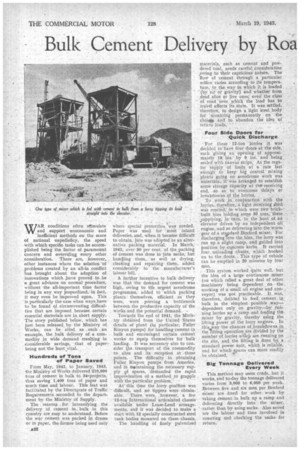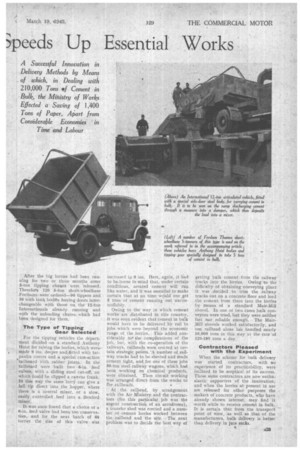Bulk Cement Delivery by Roa 3peeds Up Essential Works
Page 24

Page 25

If you've noticed an error in this article please click here to report it so we can fix it.
A Successful Innovation in Delivery Methods by Means of which, in Dealing with 210,000 Tons cof Cement in Bulk, the Ministry of Works Effected a Saving of 1,400 Tons of Paper, Apart from Considerable Economies in
Time and Labour
WAR conditions often stimulate and support uneconomic and inefficient methods on the score of national expediency, the speed with which specific tasks can be accomplished being the factor of paramount concern and overruling every other consideration. There are, however, other instances where the solution -of problems created by an all-in conflict has brought about the adoption of innovations which ,have proved to be a great advance on normal procedure, without the all-important time factor being in any way jeopardized, in fact, it may even be improved upon. This is particularly the case when ways have to be found of circumventing difficulties that are imposed because certain essential Materials are in short supply. The story published below, which has just been released, by the Ministry of Works, can be cited as . such an example, the bulk delivery of a commodity in wide demand resulting in considerable savings, that of paper being not the least vital.
Hundreds of Tons of Paper Saved
From May, 1942, to January, 1943, the Ministry of Works delivered 210,000 tons of cement in bulk to. 34-projects, ' -thus saving 1,400 tons of paper and much time and labour. This feat waS facilitated by the Directorate of Traffic Requirements .seconded to the depart, meat by the Ministry of Supply.
The reasons for intensifying the delivery of cement in.. bulk in this country are easy to understand. Before the svar cement was packed in drums or in paper, the former being used only
a22
where special protection was needed. Paper was used for 'most inland deliveries, and, when it became difficult to obtain, jute was adopted as an alternative packing material. In March, 1942, over 50 per cent. of the packing of cement was done in jute sacks, but handling them, as well as drying, cleaning and repairing them, added considerably to the manufacturer's labour bill.
A-further incentive to bulk delivery was that the demand for cement was high, Owing to tlfe urgent aerodrome programme, added to which packing plants themselves, efficient as they were, were proving a bottleneck between the productive capacity of the works and the potential demand.
Towards the end of 1941, the Ministry obtained from the United 'States details of plant (in particular, Fuller . Kinyon pumps) for handling cement in hulk and encouraged certain cement works to equip themselVes for • bulk loading. It was necesstry also to consider the transport of the commodity to sites and its reception at .those points. The difficulty in obtaining Fuller Kinyon pumps from America, and in restintaining the necessary supply of spares, demanded the rapid improvization of a method ,to grapple with the particular problem.
At this time the lorry position was difficult, and no tippers were obtain-: able. There were, however, a few 12-ton International articulated chassis' available under Lease-Lend arrangements, and it was decided to make a stirt with 12 specially constructed steel tank bodies mounted on these chassis.
The handling of finely pulverized
materials, such as cement . and powelered coal, needs careful consideration ,Owing to their capticiOus. nature. The flow of cement through a particular orifice varies according to its temperature, to the way in which it is loaded .(lay air .or gravity) and whether from dead silos or live ones; even the class of road over which the load has to travel affects its State. It was settled, therefore, to design a light Steel. body for 'mounting permanently on the chase and to abandon the idea of return loads.
Four Side Doors for
:Quick Discharge For these I2-ton lorries it was decided to have four doors at the side, each giving an opening of approximeta}, It3;ins. by 9 ins, and being sealed with canvas stripe.. As the regular SUPply of loads af a rate fist enough to keep big central mixing plants going on aerodrome Work was uneertain, it Was arranged to establish some storage Capacity at th# receivingend, so as to overcome delays or , breakdowns of the lorries. To work in conjunction with the lorries,.therefora light receiving Shed. was erected; in which were two brick-' built bins holding some 30 tons, "these ;applying, in-turn, to the boot of an elevator driven by an "independent oil engine, and so deliverinr, into the worm gear of a stydard Beneord mixer. For discharging into the bins, the lorry was run up a slight ramp, and guided into position by concrete kerbs. It carried four unloading chutes which hooked ,
on to the doors. This type of vehicle can be emptied in 20 minutes by four men, This system, worked quite well, but the idea of a large continuous -mixer (on which relied a great deal of other,
machinery being dependent On.-the • working of a small oil engine and coo: veyor) was not practicable. It was, therefore, deeided to feed cement. bulk in the simplest possible way-7, dependent only . on gravity—by run, ning lorries up a ramp and feeding tlit mixer by gravity, thereby using the lifting power of the lorry engines. , this way the chances of breakdowns, ia thellfting operation are divided by the . number of lorries wgick are runnincon the site, and the lifting is done by, a standard power unit, which is reliable, and for which spares can more readily he obtained.
Big Tonnage Delivered " Ever* Week
This method may seem crtide, but it works, and to-day the tonnage delivered varies from 3,000 to 6,000 per week. Between five and six men per I3enford mixer are freed for other: work by taking an:tent:in bulk up a ramp and delivering directly into the mixer, • -rather than by-using sacks. Also saved are the labour and time involved in counting and chedking the sacks for return. After the big lorries had been running for two or three months some S-ton tipping chawis were released. . Therefore 120 5-ton short-wheelbase Fordsons-were ordered-90 tippers and 30 with tank boditis having doors interchangeable with those on the 12-ton Internationals already running and with the unloading chutes-which had been designed for them.
The Type of Tipping Gear Selected
, For the tipping vehicles the department decided -on a standard. Anthony floist for raising the bodies, which were-, made 9 ins, deeper and,fitted with tarpaulin covers and a special cam-action tailboard N:ith rubber joints. In the tailboard were built two 6-in, feed valves, with a sliding steel cut-off, on which Could be clipped a canvas frank. In this way the same lorrY can give a Lull tip direct into the hopper, where there is a central mixer, or a slow. easily. controlled feed into a..Benford mixer.
It was soon found that a choice ot a. 6-in, feed valve had been too conservative, and for the next batch of 60 lorries the size of this valve was increased to 9 ins. Here, again, it had to be..horne in mind that, under certain conditions, aerated cement will run like water, and it was essential to make certain that at no time vcCuld one set 5 tans of cement running out uncontrollably. Owing to the way in Which cement works are distributed in this country, it was soon evident that cement in bulk would have to be delivered bY rail to jobs which were beyond the economic range of the lorries. This added considerably to, the complications of the job, but, with the co-operation of the railways, railheads were erected at certain strategic points. -A number of railway trucks had to be sheeted and made cement tight, and for one of these jobs 50-ton steel railway wagons, which had been working on chemical products, were obtained. Then circuit working was arranged direct from the works to
the railheads. •
At the railhead, by arrangement with the Air Ministry and the contractors (for this particular job was the urgent constraiction of an aerodrome), a transfer shed was erected and a number of cement lorries worked between the -railhead and the site. The next problem was to decide the' best way of getting bulk cement from the railway trucks ,into the lorries. Owing to the difficulty of obtaining conveying plant it was ,decided to trim the railway trucks out on a concrete floor and load the cement from there into the lorries by means of a standard Muir-Mill shovel. In one or two cases bulk conveyors were tried, but they were neither fast nor reliable enough. The Muir• Mill shovels worked satisfactorily, and one railhead alone his handled nearly 10,000 tons in this way at the rate-of 120-180 tons a day,
Contractors Pleased with the Experiment
When the scheme for bulk delivery was started contractors, with no experience of its practicability, were inclined to be sceptical of its success. Those same contractors are now enthusiasticsupporters of the innovation, and when the lorries at,present in use are released for other purposes the makers of concrete products, who have already • shown intefest, may find it worth while to receive cement in hulk. It is certain that from the transport point of view, as well as that of the manufacturers, bulk delivery is better than delivery in jute sacks.




















































